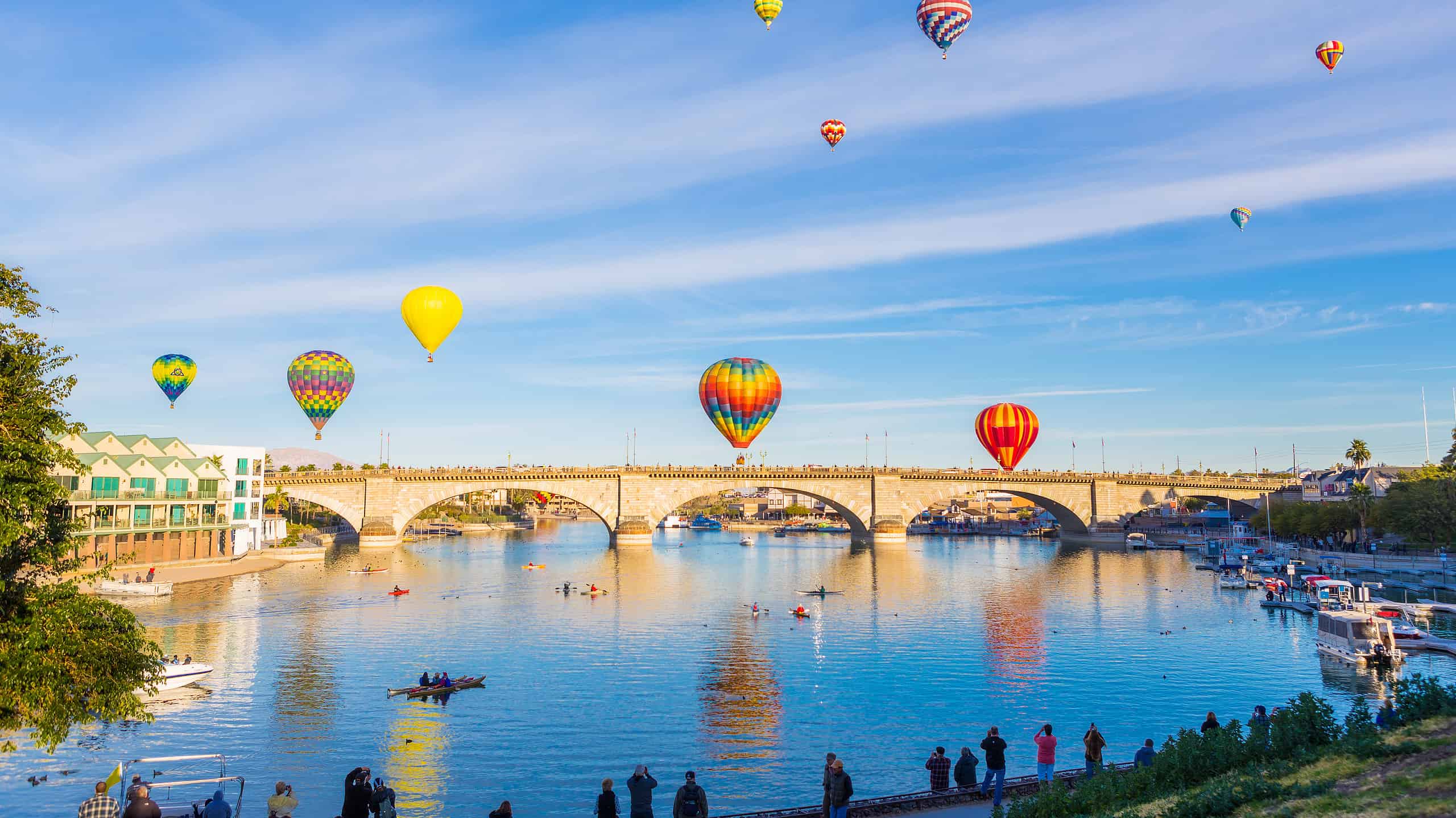Known as the Grand Canyon State, Arizona has a ton of incredible, beautiful landscapes and natural wonders to offer its residents and visitors. The folks who live there pride themselves on the outdoor lifestyle the region offers, along with the fantastic photo opportunities, delicious food, and, of course, the unique and inspiring history of the people of the state.
Let’s check out what else the state is known for – and why Arizonians love their home.
The Grand Canyon
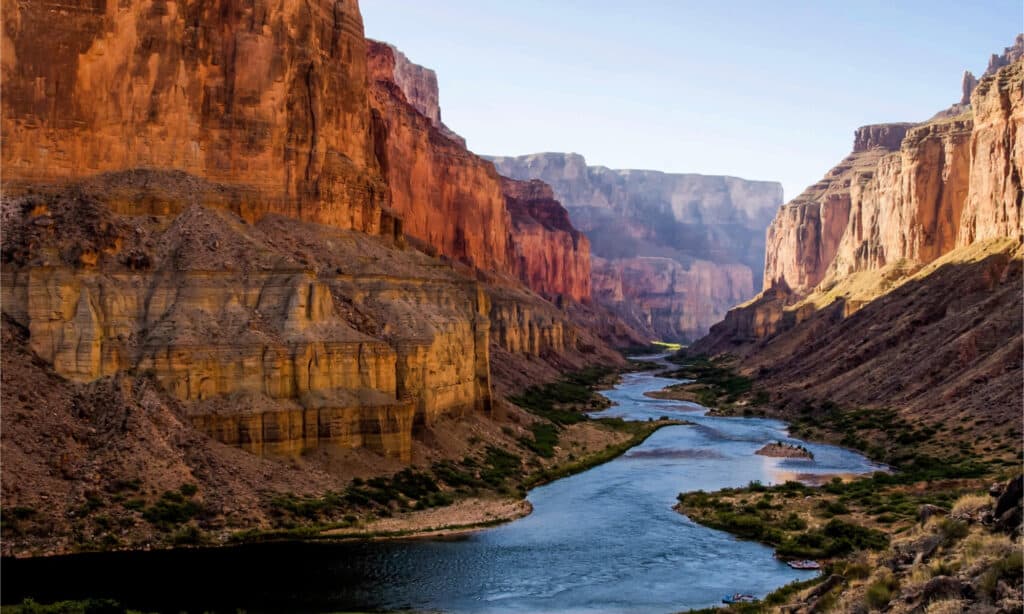
The Colorado River in the Grand Canyon.
©Beth Ruggiero-York/Shutterstock.com
International fame for Arizona resides in one of the Great Natural Wonders of the World: the Grand Canyon. Extending 270 miles from Lees Ferry near Lake Powell all the way to the Grand Wash Cliffs east of Lake Mead, the canyon takes the record for the longest in the world. The canyon with its incredible vistas, stunning sunsets, and intriguing wildlife is only one mile deep, though, meaning hiking down in is possible for many. For those less athletically inclined, a hike along the South Rim Trail is a better choice – anyone can enjoy the views from there.
The Five Cs of Arizona

Cattle, citrus, copper, cotton and climate make up the 5 Cs of Arizona.
©Bob Pool/Shutterstock.com
There’s something known as the Five Cs of Arizona, which are all about things Arizona as a state is most known for in economic terms.
- Copper
- Cattle
- Citrus
- Cotton
- Climate
With at least 27 copper mines in the state, Arizona is responsible for approximately 65% of the entire country’s copper production. The state also produces around 1 million head of cattle each year, producing some 386 million pounds of beef. Annually, Arizona produces between $55.5 million and $23.3 billion worth of citrus. Cotton production in the state is massive, too, with upward of 334,000 bales of cotton weighing 480 pounds each.
Of course, the climate point is one C most of us can directly relate to when we visit: Arizona has great weather all year-round. The state consistently sees 300-plus days of sunshine each year, with only about 8-inches of rainfall annually. The mild climate draws folks from all over the world in wintertime and sun worshippers in the summer months.
Native American Culture

Native American hogans are on the Navajo Nation reservation at Monument Valley, Arizona, USA.
©iStock.com/535455604
22 federally recognized Indigenous Nations reside within Arizona. Each has its own unique traditions and customs. Many well-known groups like Navajo, Hopi, and Pueblo are included in this, as well as less commonly heard of. Throughout the state, you can experience a taste of the Indigenous culture through the arts, performance arts, music, and crafts. Throughout natural parks and trails, as well, you’ll see history. If you’re lucky, you may have the honor of observing some of the sacred sites.
Piki Bread
If you’ve ever heard of blue corn, you’ve heard of Arizona maize. This blue cornmeal is used to make thin, crunchy bread with a slightly sweet flavor. The bread is known as Piki bread and usually served with honey or jam. It’s super popular among the Hopi people, a long-standing traditional food used in celebrations and ceremonies alike. You can also find it available for breakfast and snack food, depending on where you look.

Piki bread is made from blue corn or Arizona maize.
©https://www.flickr.com/people/37996646802@N01, CC BY 2.0 – Original / License
Saguaro Cacti

Saguaros and small cacti grow in Sonoran Desert at Saguaro National Park, Tucson, Arizona, USA.
©iStock.com/Nate Hovee
It’s hard to think of Arizona without picturing the iconic saguaro cacti. The plant is native to the Sonoran Desert of the southwestern United States, growing to 50 feet or taller. The flower of the plant is the state flower of Arizona and has become the symbol of the desert southwest. Art and literature frequently feature this intriguing plant. And tourists flock to see the cacti in the wild, particularly in the Saguaro National Park, named for the cacti.
Turquoise
Folks visiting Arizona are bound to spot many shops along the roadsides offering turquoise jewelry for sale. There’s a reason for that: turquoise is synonymous with Arizona. The stunning semi-precious stone frequently finds pairing with silver settings. Commercial mining of the stone began in the later 1800s and continues to be mined today in Arizona. The state is the key producer of the stone.
The unique gemstone is particularly known for its use in artwork and jewelry work. Most famously, work created by the Zuni and Navajo is thought by some to represent health, happiness, and wealth. Many tourists buy turquoise stones as their primary souvenir from their visit to the Grand Canyon State.

Arizona is known for turquoise jewelry and other artwork.
©AkulininaOlga/Shutterstock.com
Monument Valley

Monument Valley in Arizona. is an iconic destination.
©Nature’s Charm/Shutterstock.com
An area of the Colorado Plateau, on the border of Utah and Arizona, Monument Valley is one of the most iconic sights of the state of Arizona. Monument Valley is located within the Navajo Nation Reservation, situated within the Navajo National Monument Park. You’ve probably seen the iconic sandstone buttes in movies from the 1930s and 1940s. For the park itself, an entry fee is required to enjoy the stunning natural beauty, but permits are required for anything beyond the park’s borders. Most of the hiking trails require you to follow a guide, as well.
Most folks suggest angling your time in the park toward sunset. This offers the most spectacular views of the sandstone when the colors shift into incredible pink shades. Driving through the park is possible, as well, if you’re not up for a long hike. Expect about 2 to 3 hours for the best experience driving.
Sonoran Hot Dogs
As you can guess by the name, Sonoran Hot Dogs are popular in the Sonoran Desert region. These are loaded dogs. So, be prepared for a hot dog wrapped in bacon, then grilled, and loaded up with onions, mustard, mayonnaise, tomatoes, and jalapenos. The dogs typically can be found as street food in both Arizona and California. They’re sold in food carts or food trucks, as well as casual dining joints.
Hoover Dam
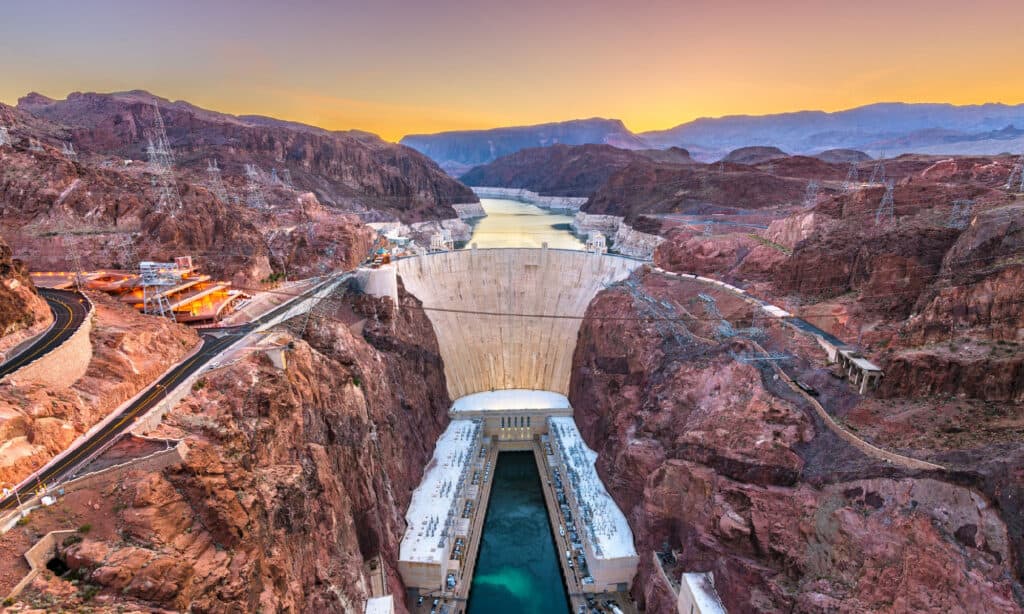
Hoover Dam is the second-largest dam in the U.S.
©iStock.com/Sean Pavone
Perhaps the second most iconic place in Arizona, the Hoover Dam demonstrates some of the most incredible American engineering in history. The dam was finished in 1935, linking Arizona and Nevada, creating Lake Mead (the largest artificial lake in the country). The dam is close to Las Vegas, with guided tours and special events held at the dam throughout the year. Heat greets you as you tour the dam, for sure, especially in the summertime. And your car may be restricted from crossing the dam as you venture out.
The Arizona Balloon Classic
Every year, the Arizona Balloon Classic draws thousands of visitors to Goodyear, Arizona. Each January, food vendors, musicians and bands, artisans, and more come together to celebrate the incredible balloon. They fill the balloons and raise them into the air, thus creating a cloud of color and glow cloud by night. Folks can experience it all, too, including hot air balloon rides.
The Red Rocks of Sedona

Yes, sometimes it snows in Arizona.
©Monica Lara/Shutterstock.com
Making your way through Arizona just wouldn’t be right without a visit to Sedona and her red rocks. The stunning scenery and comfortable climate welcome hikers of all ages and skill levels to enjoy. There’s also a burgeoning artist community in Sedona. So, visitors can find a painting or other artwork to commemorate the glorious beauty of stunning Sedona. Other hiking trails, mountain biking trails, fine dining, gorgeous views, and more, as well draw folks in. Plus, the Sedona Arts Festival, Sedona Jazz Festival, and Sedona International Film Festival.
Spanish Missions
Built in the 17th and 18th Centuries, Spanish missions in Arizona have become a symbol of the state. Their unique architectural style blend together Native American and European elements, blending into the landscape perfectly. The thought behind all of the missions was to convert Native Americans to Catholicism. While the intent of the colonists is far from ideal, the missions still greatly impact the history and culture of Arizona. Today, the missions are among the most popular tourist attractions. Some of the most distinctive and frequently visited missions include San Xavier del Back and San Agustin del Tucson.
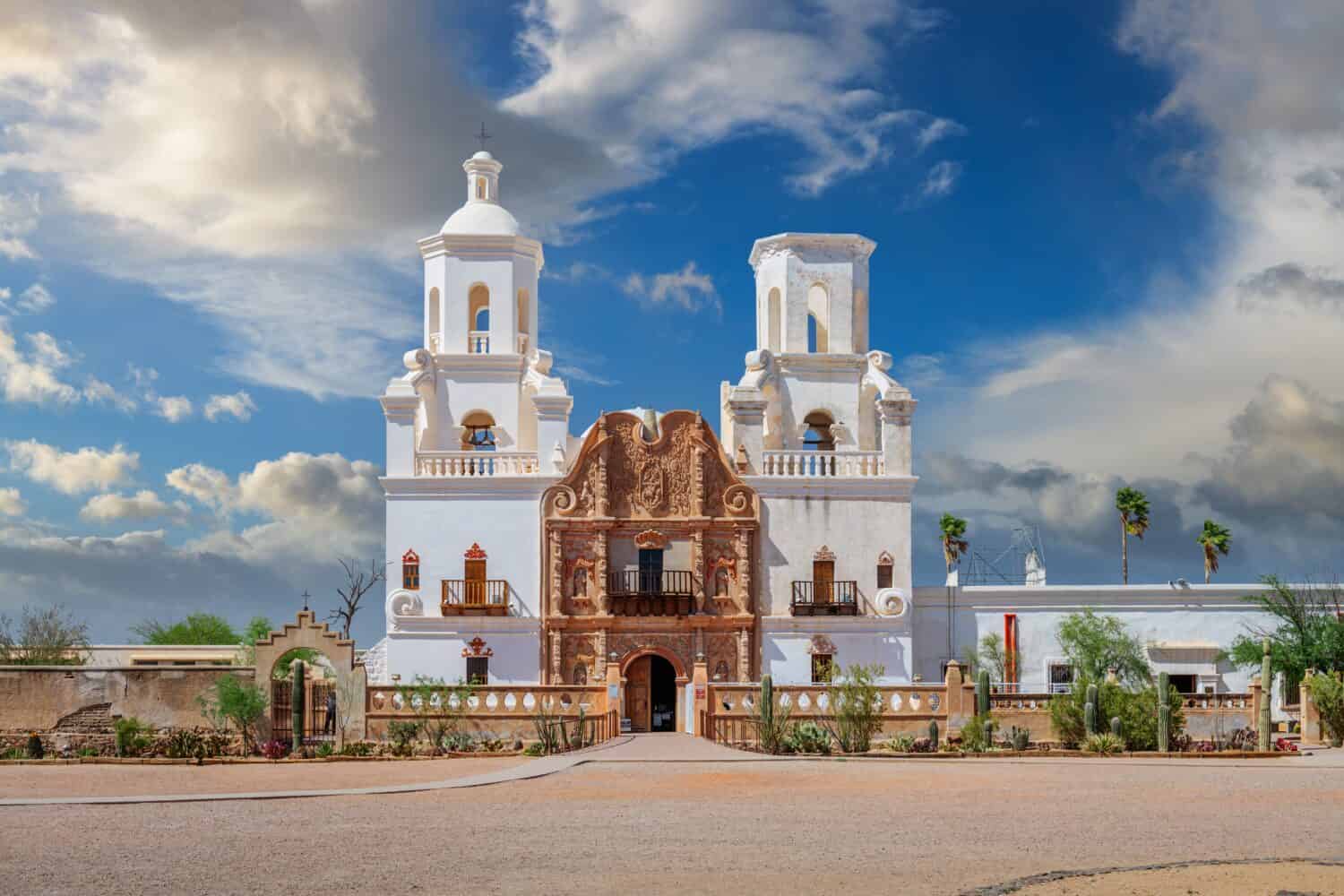
Mission San Xavier del Bac is located in Tucson, Arizona, USA.
©Sean Pavone/Shutterstock.com
Petrified Forest and Painted Desert National Parks
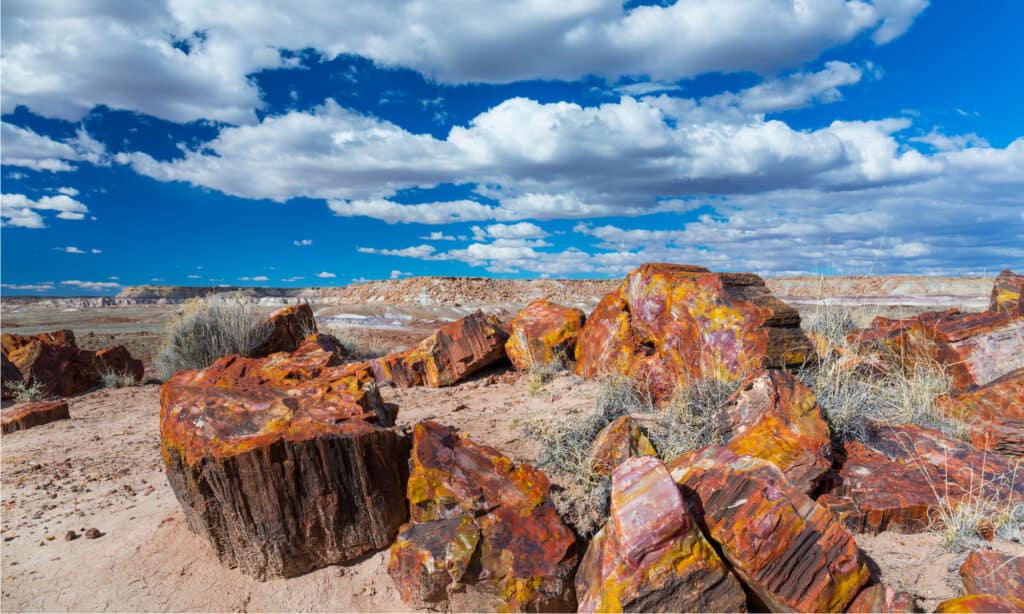
Petrified Forest National Park has trees formed by volcanic eruptions.
©Juan Carlos Munoz/Shutterstock.com
National Parks and major state parks come abundant in Arizona, including the amazing Painted Desert and Petrified Forest National Parks. The parks sit in Apache and Navajo land, with Puerco Pueblo present as well, the ruined village of the Pueblo Indigenous peoples. The petrified trees you can see all over the park were formed by volcanic eruptions that petrified the trees.
The parks blur together but are distinctive from each other. When you enter one, you’re near the next. The Petrified Forest National Park is also along the historic Route 66, which adds additional attraction.
The Painted Desert sits within the vast badlands running east from the Grand Canyon into the Petrified Forest National Park. Most of this desert portion is within Navajo land. The layers of clay and sandstone live up to the name with many colors “painted” across the layers of cliff walls. Ideally, visit the Painted Desert during sunset for the most visual impact.
Glen Canyon
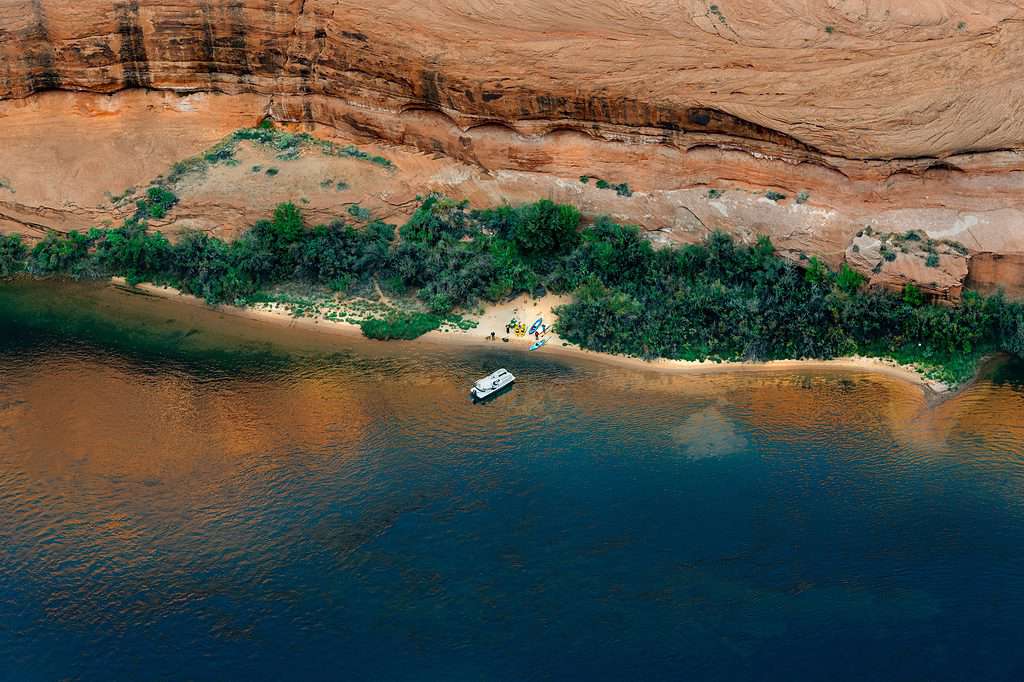
Glen Canyon has a lot of gorgeous flora.
©HannaTor/Shutterstock.com
Arizona could be called the canyon state easily without the Grand Canyon. Glen Canyon is a smaller canyon in the National Park system. The canyon reaches from the northern side of the Grand Canyon and stretches toward southern Utah. The canyon offers truly incredible views of the Colorado River and the human-made Lake Powell, formed by the Glen Canyon Dam. The lake and canyon offer many options for outdoor activities and water sports. Some of the most popular include fishing, kayaking, jet skiing, and boating. Loads of four-wheel drive trails and hiking welcome visitors as well.
Navajo Tacos
Another local cuisine favorite goes by the name of the Navajo taco. These are made with Navajo-style flatbread known as frybread. The bread is topped with cheese, lettuce, tomatoes, beans, and other tasty toppings. The frybread is a traditional favorite meal that’s been enjoyed for centuries by the Navajo Nation. It’s made from water, salt, flour, and baking powder.
The London Bridge – Transported from London
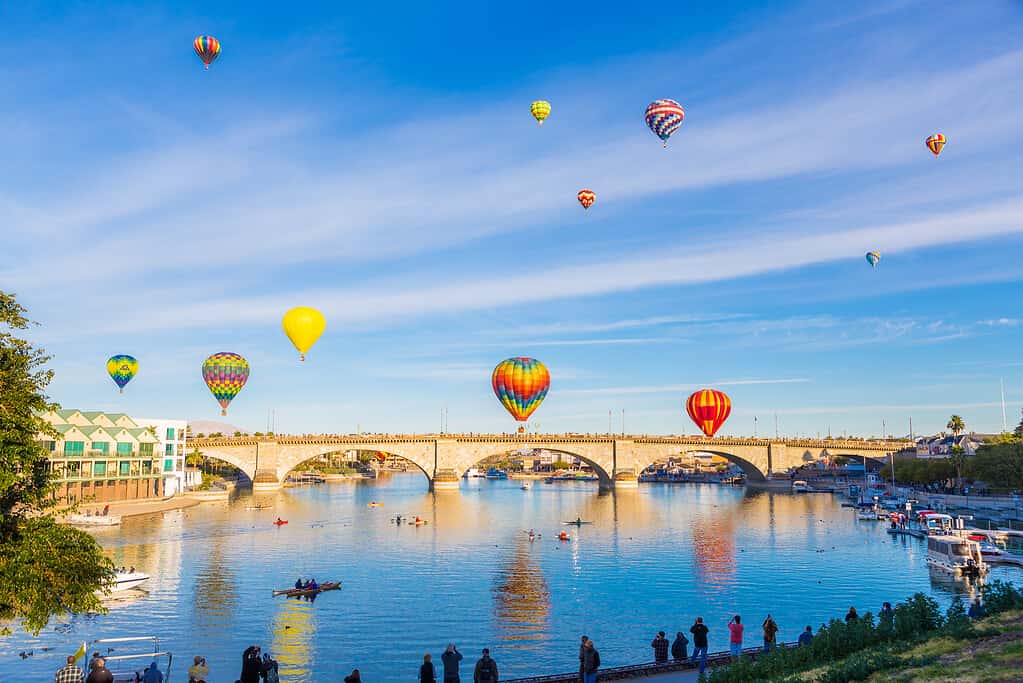
Multiple hot air balloons ascend over the London Bridge, in Lake Havasu City Arizona. This occurs during the annual the air balloon festival.
©iStock.com/AngelMcNallphotography
While it might be a bit surprising, Arizona is known for the actual London Bridge. The famous bridge has been through various iterations over the years. And one of those versions made its way into the Grand Canyon State. The version here was commissioned in London in 1799, designed by John Rennie. This was the “new” London Bridge that was finally finished in 1831.
As motor vehicles weigh a lot more than horse and buggies, the bridge weakened under the traffic. So, the City of London Council put the bridge up for sale. Robert P. McCulloch, the founder of Lake Havasu City, bought the bridge and paid for its dismantling and transport into Arizona. Now the bridge, after being rebuilt, stands in Lake Havasu City. An extra bonus of European history comes in the form of the lampposts along the bridge. These were made from melting down cannons of the British army used to defeat Napolean at Waterloo.
Horseshoe Bend
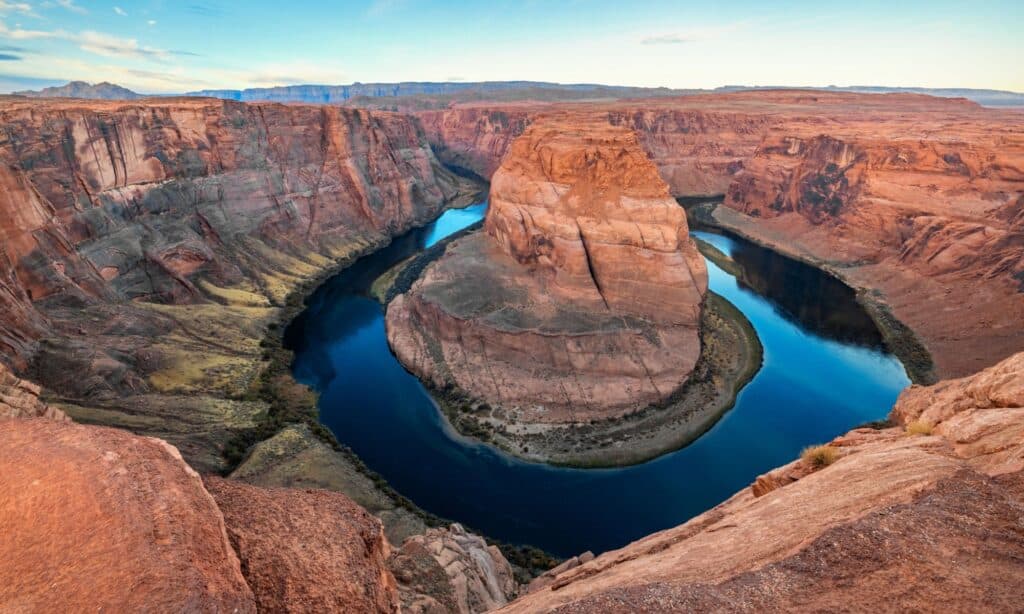
The Colorado River flows into Horseshoe Bend.
©Lebid Volodymyr/Shutterstock.com
Take a 1.2-mile hike to the overlook of the Horseshoe Bend for moderately easy access to an incredible sight. The Colorado River flows into the bend. This place has become one of the most famous and most-photographed locales in the United States. That’s thanks to its 1,000-foot sandstone cliff views and the gorgeous water-filled U-shaped curves. The hike is just outside of Page. There you can hire a backhaul service for kayaking into the Bend or rent equipment for the adventure.
Four Corners
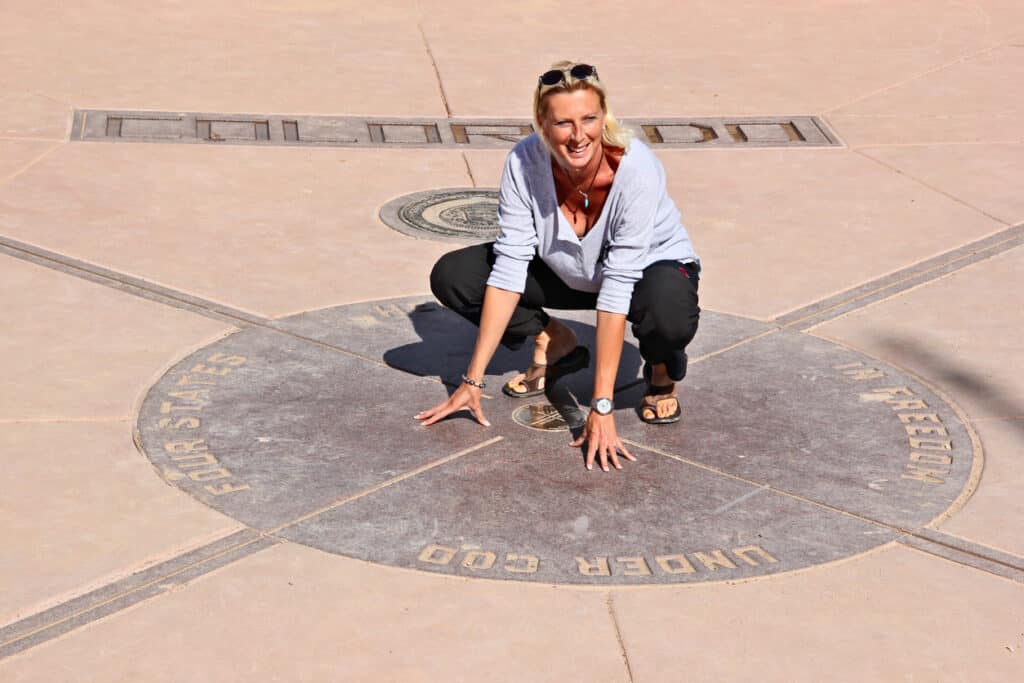
Arizona, Colorado, Utah, and New Mexico converge at Four Corners Monument.
©iStock.com/Martina Birnbaum
Did you know that there’s only one spot in the USA where four states “touch” each other at a single point? That place is, of course, in Arizona and known as Four Corners. A metal plaque marks the location. You can stand on it to take photographs of yourself while you stand in four states at the same time. The Four Corners belong to Arizona, Colorado, Utah, and New Mexico. Lay down for the full effect, stretching out into all four states for the most fun picture of all.
Tombstone
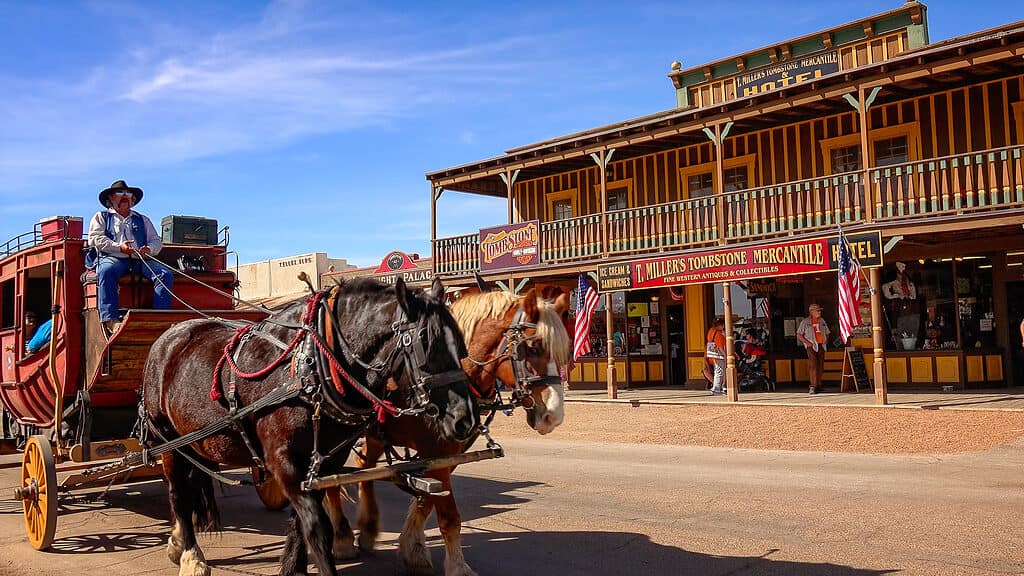
Visit Tombstone for a taste of the Wild West.
©iStock.com/CrackerClips
Perhaps the most famous historical town is Tombstone, the place of legendary cowboys and shootouts – and the O.K. Corral. The historic town was home to the world-famous gunfight between Virgil, Wyatt, and Morgan Earp, with Doc Holliday, against the outlaws known as The Cowboys. The shootout lasted only 30 seconds, at 3 pm on Wednesday, October 26, 1881. The mining town nearly became a ghost town, but for the Wild West legend of the place thanks to that shootout. When you visit, you can witness reenactments of the gunfight up to three times a day.
Antelope Canyon
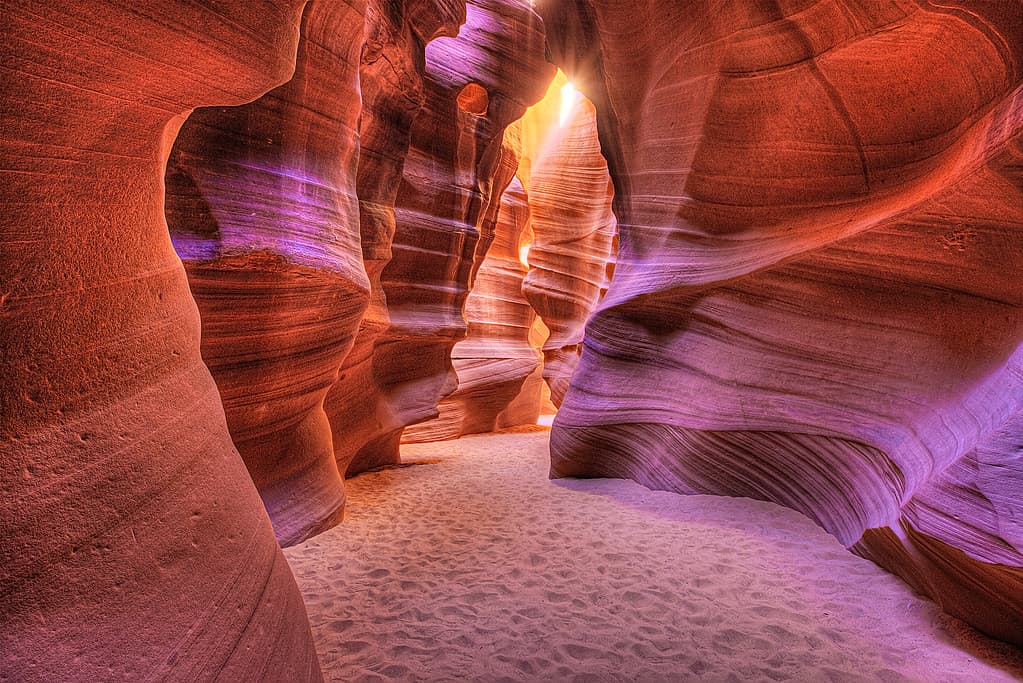
Glowing walls of the
Antelope
Slot Canyon, Page, Arizona are a natural wonder carved by erosion from Navajo sandstone.
©iStock.com/Left_Coast_Photographer
The Grand Canyon, Horseshoe Bend, and Antelope Canyon probably make up the three most famous natural wonders in Arizona. Antelope Canyon is a slot canyon, carved by erosion from Navajo sandstone. The canyon lies within the protected Navajo land. So, to visit, you’ll need to head to the welcome center and book in for a walking tour led by a local authority guide. The narrow, deep slots explode with vivid color any time of day. But particularly at sunset, the light hits the sandstone and turns it pink. The best time to visit is between March and October for the best lighting.
Taliesin West – Frank Lloyd Wright Home
Scottsdale, Arizona is home to the Taliesin West, a Frank Lloyd Wright-designed home. The building was intended to function as a winter home and design school. Organic architecture incorporates natural, local materials into its construction, specifically sandstone blocks and adobe mortar. Built-in elements like overhangs and windows intentionally blend into the native desert surroundings. So, when you enter, it feels, in some ways, like you’ve not even left the outdoors. Join for a guided tour to learn the history and more, or visit for some of the special events.

Taliesin West, an example of organic architecture designed by Frank Lloyd Wright, is in Scottsdale, Arizona.
©AndrewHorne, Public domain, via Wikimedia Commons – Original / License
Thank you for reading! Have some feedback for us? Contact the AZ Animals editorial team.

